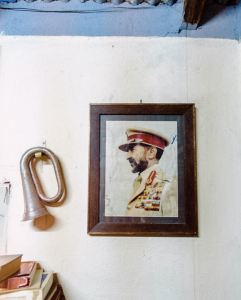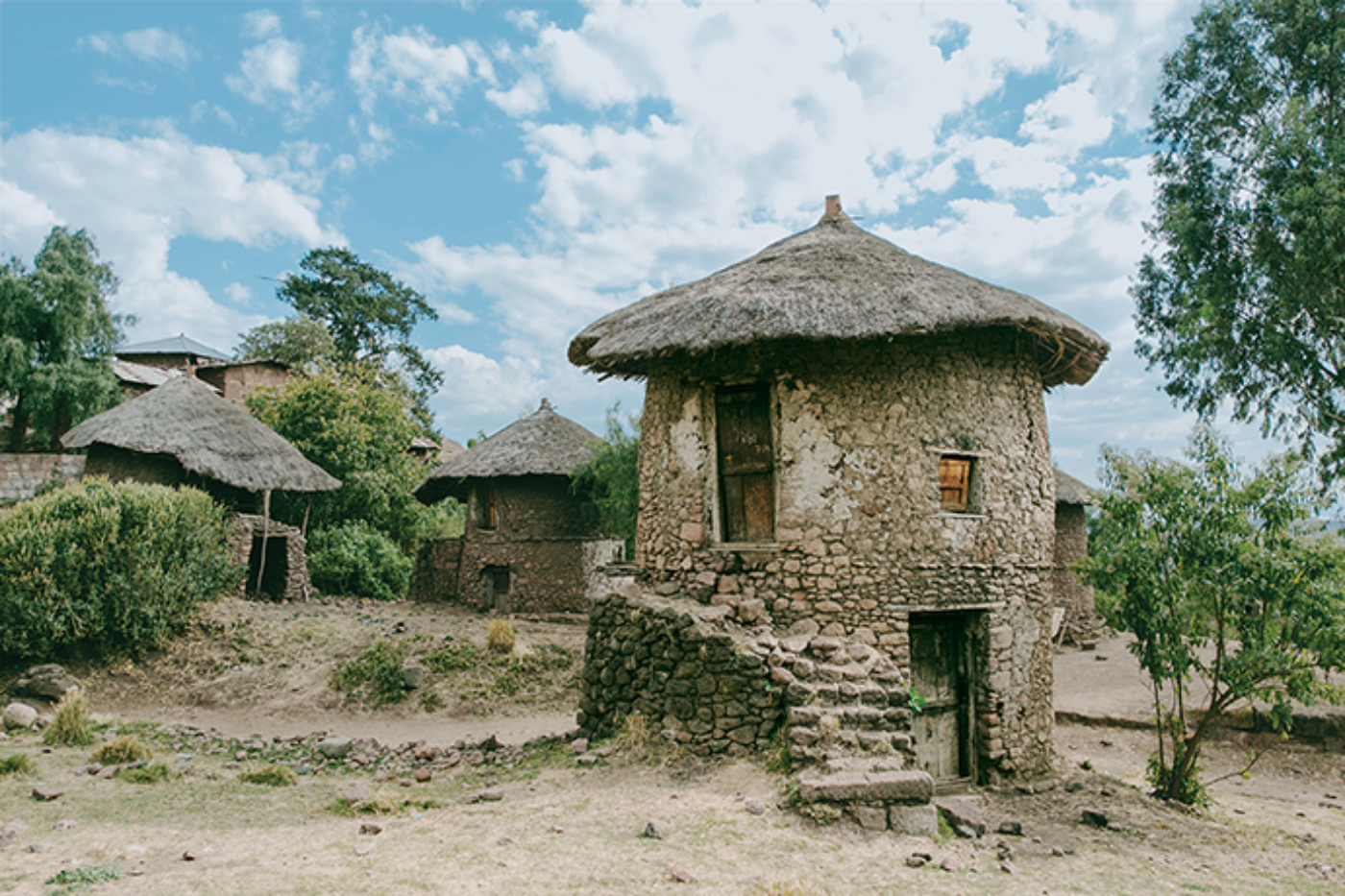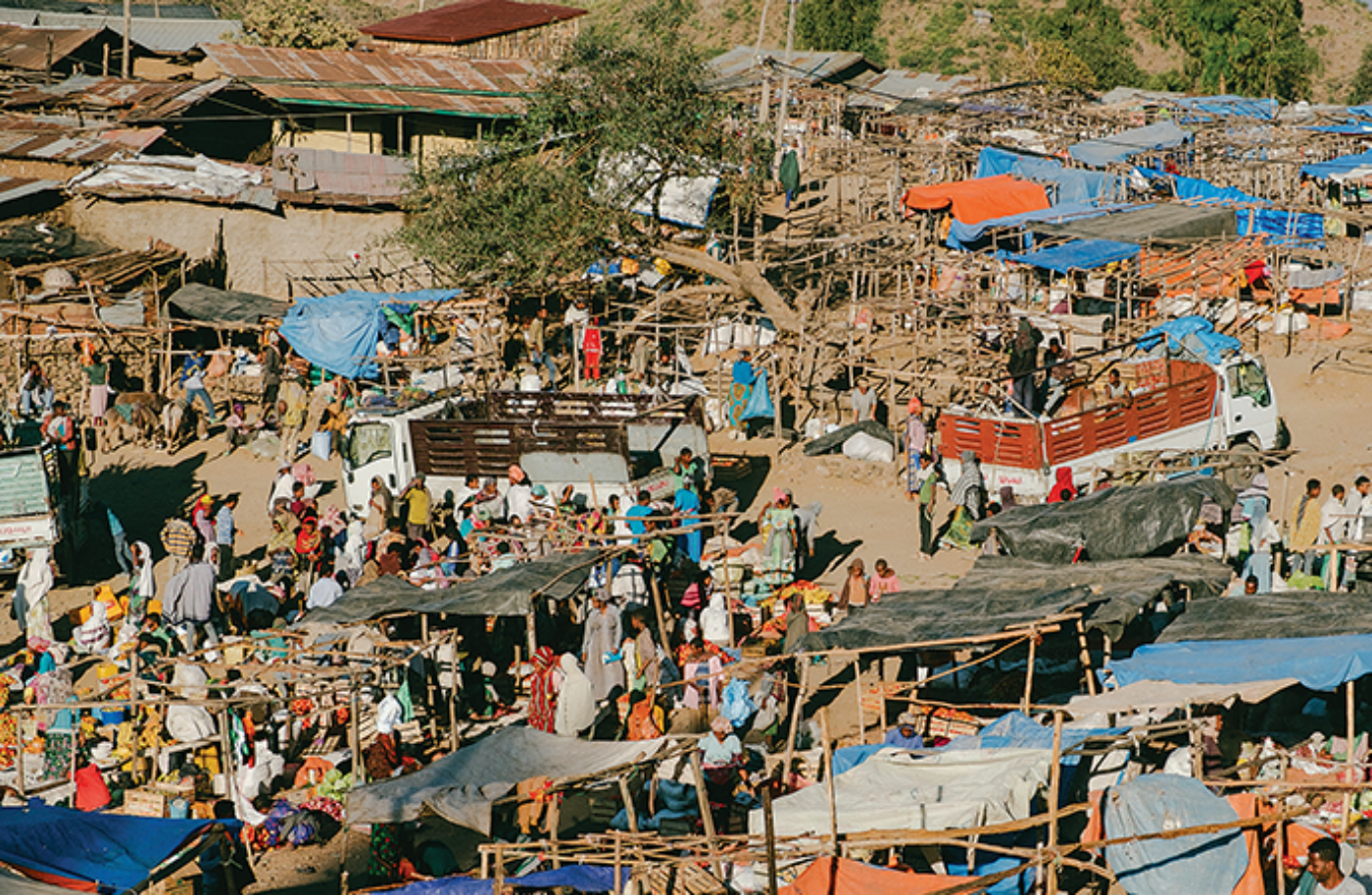Dreams of Stone
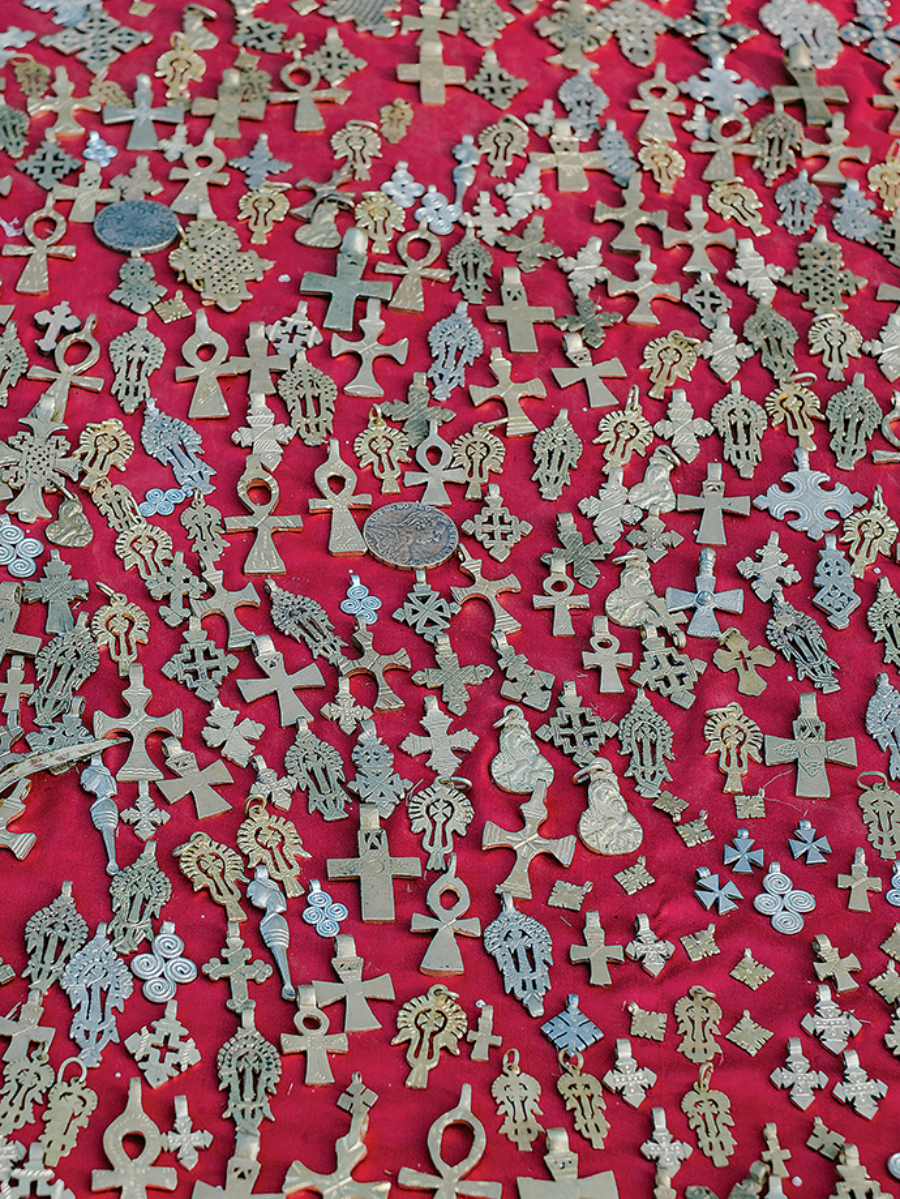
Crosses for sale in Lalibela
All photographs from Ethiopia, February 2020, by Girma Berta for Harper’s Magazine © The artist
As the van from the small airport climbed the rough-terraced mountain and the sky came close again, the driver asked what had brought me to Lalibela.
I didn’t know what to tell him. I wasn’t a pilgrim, but nor was I strictly a tourist, like the tens of thousands of people who come each year to see the rock-hewn churches in the North Wallo zone of Ethiopia’s Amhara region. I wasn’t sure what I was. Saying “To see paradise, my childhood homeland, but not really, because . . . ” was too complicated, would have sounded dumb, so I said something reasonable and kept quiet for the rest of the drive.
But paradise was why I had come. The idea of paradise, something whole yet imperfect that I’ve understood all my life only in terms of loss. With nothing but this idea, the memory of an idea—this sense of Eden gone—I had departed Addis Ababa in search of a fiction spoken of in my childhood in Jamaica, in search of that fiction and its double, history.
I was raised in a Rastafarian family in the countryside, hours away by winding road from Kingston, a place that even in the Eighties folks still simply called “town.” Throughout my boyhood in Portland and St. Thomas parishes, on the cane and banana farms that entrapped imaginations on the eastern coast, Ethiopia existed as the future fulfillment of our tragic slave past.
To the rest of the world, Rastas may seem to be black hippies: long-haired vegans practicing free love, always stoned. In reality, Rasta is a complex religion in which the late Ethiopian emperor Haile Selassie is not a god but God. Desperate were the conditions in the aftermath of enslavement in Jamaica, and neither the Western Christian churches nor the remembered West African religions seemed quite to fit the facts on the ground. We wanted a black god, but we also wanted him to be Christian.
“Jamaica is literally hell for the black man, just as Ethiopia is literally heaven,” was a common expression I heard as a boy. “Ethiopia awaits his creators,” the Rastafarian elders said also, almost to themselves. The word “Lalibela” was like the threshold of heaven when it was pronounced.
If I took the elders’ sayings for prophecy, I never envisioned actual travel. No one I knew as a child had ever been to Ethiopia. There was a guy who’d gone to England, and his nickname was thus Ivor British. Later, in high school, and more fervently in the upper grades, I was taught that our forebears originated not in Ethiopia but in West Africa. This struck a cardinal blow to the idea of terrestrial paradise invoked daily: our ancestral claim was absurd; an entire life philosophy had been compromised.
The knowledge did not diminish, though, the private awe of what I had heard as a boy. The rosary of Ethiopian place names chanted—Axum, Gondar, Shashamane—fixed itself in me as a truth deeper than fact, and that eternally beautiful word, Lalibela, settled and grew into something unreal in my mind, a distant planet, vague as snow to me who had never seen snow. I had, from early on, a scriptural, milk-and-honey impression of the place: a potent but indefinite sense of geographical mass. There the link between people and place was unbroken—a fact that at once divided me from and brought me closer to its enigmatic center. Then I arrived, and instantly the wonder took on real divine proportion.

Townspeople on the way to Lalibela’s Saturday market
As I sit at home now in upstate New York, thinking back five years to 2015, when I visited Lalibela, this is how memory has assembled that place for me: chalk-white cattle; herders in brightly colored wraps or plain white like the cow horns; children on the roadside, often carrying plastic or clay buckets; thatch houses with dung roofs and cinder-block houses mostly unfinished in the valley below.
You cannot see the churches as you approach the peaks of the Ethiopian Highlands, as you can the towering steeples of European or South American capitals. The grand cathedrals of Lalibela are hidden—built into the ground. One first comes upon them from above, and they appear as if each had been constructed, placed on a freight elevator, and lowered several stories down a stone-lined shaft. As whimsical as this might seem, it is less awe-inspiring than the truth. The churches—eleven total, some with wide, elaborate plazas—were hand-carved out of stone, working downward into the rock. Every lintel, every doorway, every porch and step.
With the knowledge of what lay beneath, each thing I passed, some of them ordinary and familiar, seemed to levitate: every single person belonged to the churches hidden in the mountains, where eucalyptus leaves glinted their mirror signals. The closeness of the rock-hewn wonders seared suddenly like the phantasmal tug of reality in a dream.
After a forty-minute drive from the airport, I got to my hotel, Sora Lodge, where I wasted no time before hurrying back out with my guide, Theo—hurrying like someone in pursuit of something to reclaim or something that would reclaim him. Theo was of average height, late middle-aged, stubble-chinned, with kind, almond eyes. He had waited over three hours for my delayed plane from Addis Ababa. He was not certain I would see all eleven churches. “A good fortune nonetheless,” he said cheerfully, for this late—it was just after three in the afternoon; I was supposed to have been there at noon—I would likely be the only visitor. “What you see you will see alone.”
The sky was no longer a clear blue but crimson. Theo said it might rain. He turned out to be right, on both counts. Bolting his car the two miles through what seemed to be the town square, overtaking bajaj—the ragged blue-and-white rickshaw taxis that paraded in congeries and vied in harmless fight for passengers—he spoke ceaselessly, pointing out things as they flew by the window.
At a tiny, bare crossroads we came to a stop. Though not visible, the churches began to our right, up and then down, into the mountain. At the top, we hopped out and descended a pale-red slope, which gradually hardened into a sable corniche. Layers of tufa along the rock walls grew distinct and larger as we went farther. After about ten minutes, Theo paused and placed his palms flat against a jutting boulder. He was silent awhile. I thought he was about to pray. Then he spoke, one hand weighing on my shoulder, his eyes fixed on mine. He told me plainly that I was about to see great buildings carved out of stone. He spoke not simply to praise the churches. His eyes held mine. I realized, or felt, he was initiating me into the lifeblood of the place. It moved me greatly, a boy from across the ocean. He was welcoming me back.
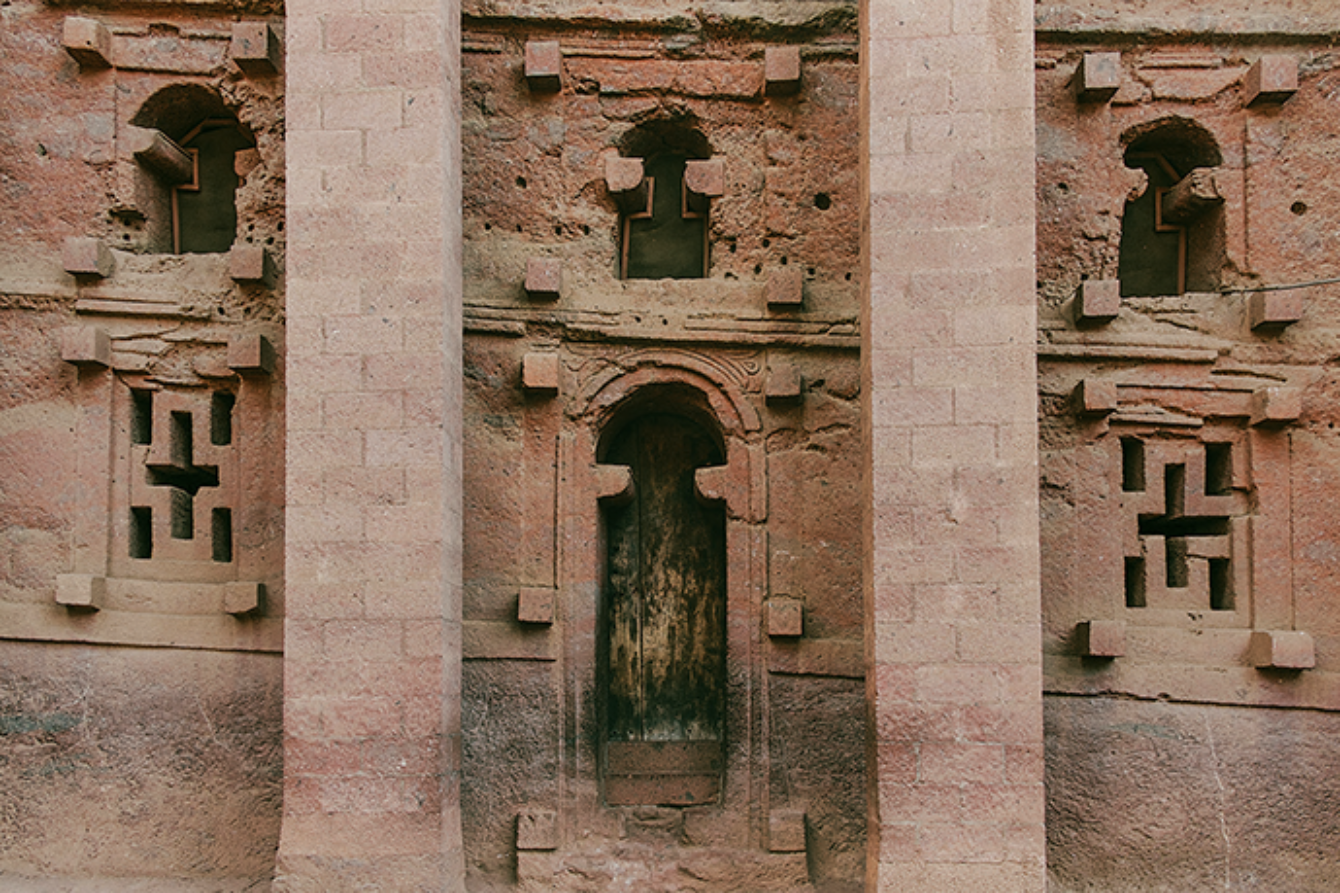
The façade of Biete Medhane Alem
In Addis Ababa, people had seen at a glance that I was Jamaican. Travel often reduces a person to his starkest identity, and in that city it was the appearance of Rasta that inflected each of my social interactions. A man in the Wabe Shebelle Hotel bar, finishing his coffee, told me that if it were not for the Rastafarians in Jamaica the name Ethiopia would’ve been long gone from the world’s popular memory. “Like another Liberia,” he said. I didn’t get his meaning, but before I could ask he added, “It’s because Rastafarian young people know history, the struggle after the Derg.” I got his drift. The Derg was the brutal military regime that overthrew Haile Selassie in 1974. The country plunged into civil war and famine, the effects of which are still felt almost half a century later.
This was typical of my encounters with Ethiopians. We acknowledged what connected us: colonial struggle, political corruption, poverty. We relished one another’s native music. There was dancing and “spice war” jokes at dinner. I recognized the amused contempt Ethiopians have for Ethiopians returning from abroad. Jamaicans say “foreigna”; Ethiopians say “diaspora.”
Moving through the enticing chaos of Addis Ababa reminded me of Kingston, where I had lived for three years as a university student. Chaos in both cities stimulated, oddly, a certain kind of grace. It was a happiness that was tender in Addis Ababa (addis, new, ababa, flower); the mundane coexisted with the sacral: busy workaday people would stop in traffic to make the sign of the cross when passing a cathedral, a sight I had never seen in Kingston.
Yet, as in any city, there was something estranging. The close-packed buildings rose endlessly, new constructions, constricting the view of the Entoto Hills flanking the city. The buildings’ proliferation matched the city’s constant accumulation of people and moments. Some of my impressions evaporated in the haste of the place before they could quite take shape, never to repeat, which perhaps said more about my provincial internal clock. Indeed, the real spring of the estrangement was myself—for lacking Amharic, for my poor way with time when I feel it slipping fast.
In Lalibela, far away from that urban speed and within reach of the soul of Ethiopia—her churches—Theo’s words anchored within me all those fleeting moments. Anchored them permanently.
We resumed walking, turning down a coarse, narrow lane that narrowed further into a kind of tunnel. Not far off, barley patches. Women passed carrying great bundles of firewood on their heads. Some children swinging water buckets in crisscross—to lighten the load—followed along. Theo related the story of the sixteenth-century Portuguese priest and traveler Father Francisco Álvares, the first European to describe the magnificence of the churches, in his widely translated book, Narrative of the Portuguese Embassy to Abyssinia During the Years 1520–1527.
His account of Lalibela’s churches is pedestrian, rudimentary, and largely impersonal, but at a certain point, an exhausted Álvares reveals what seems to be, to my ear, in that century of vast colonization led by Portugal, a germ of European prejudice and its simultaneously rabid and mechanical dismissal of Africa’s achievement:
I weary of writing more about these buildings, because it seems to me that I shall not be believed if I write more, and because regarding what I have already written they may blame me for untruth, therefore I swear by God, in Whose power I am, that all I have written is the truth (to which nothing has been added), and there is much more than what I have written.
Father Álvares worries that “they”—his European audience—must naturally doubt him, a man of God, when he says that there exists a Christian place of such staggering feats of beauty outside known Christendom.
The phenomenon was too great to admit, this singular case in which beauty of form supersedes beauty of geometrical reality. What is this immense beauty? The archaeologist Niall Finneran calls it a “nested, concentric perception of space.” Nested space that is enough for us to formulate, as Bachelard put it, “dreams of the stone from which the principles of life are said to come.” But then, in a turn that compounds and spins his denial into the absolute untruth at the heart of Eurocentrism, Álvares writes:
They told me that all the work on these churches was done in twenty-four years, and that this is written, and that they were made by Gibetas, that is, white men, for they well know that they do not know how to do any well-executed work.
I surrendered myself to the ancient story, alert to the fresh air in the passage. Not a single gibeta on our path. When I asked Theo if the Italians did any “work” on the churches during their military occupation of the country in the 1930s, he told me that he had heard they’d inflicted, in the name of so-called preservation, a minor scourge of tar and red paint on some of the buildings, but that was in the 1950s. (According to the World Monuments Fund, the work was commissioned by the Ethiopian Empress Zewditu, who hired a Greek architect.)2
I don’t remember seeing the tar, but what remained of the sinister red paint seemed a laceration left by Italy’s imperial quest for Ethiopia, reaching back to the first war between the two nations, in 1895–96. (The Italians were defeated.) Other twentieth-century construction work on the cathedrals was carried out by the WMF, which erected protective awnings over five of Lalibela’s churches.
I glimpsed the pale-rose summit of the largest cathedral, Biete Medhane Alem (House of the Redeemer of the World). Something echoed from my boyhood, a verse chanted at Nyabinghi—the fire ceremony of Rasta resistance: “And they shall be afraid and ashamed of Ethiopia their expectation, and of Egypt their glory.” Fear and shame, and their eviler sides, terror and humiliation, have been—sometimes with the aid of missionaries no less benign than Father Álvares—the lasting legacy of foreign encounter. The night had to pass for me to see clearer evidence of that in Lalibela. But for now, the glory was not in Egypt—which also waged war against Ethiopia, from 1874 to 1876—but in Lalibela, where I was about to walk into the living rock.
As we neared Biete Medhane Alem, a service was underway; the sounds of Geez, the ancient Ethiopic liturgical language, resonated through the mighty stone pillars that greeted me before the structure itself—an auditory monument, the presence of numinous poetry, an intimation of the enormous space before me, undulating and wide. Time slowed, as it does in the opening phrase of Philip Glass’s Koyaanisqatsi, and soon in the frame of my vision, as I turned a corner, I saw the praying people. Robed splendidly, mostly in white shawls, the supplicants shuttled through the rock passages, brushing the reddish stone with their palms, kissing it; some were huddled close into tall crevices, attenuated like cocoons, or fresco marks, which then would suddenly peel off and bore deeper into the secret caverns of this mystical edifice.
Angels, it was said, worked at night, perfecting what man did by day. I accepted the theory with the same measure of cool with which Theo recounted it, leading me up to the adobe-colored arched entrance. When I touched the rock, I felt below my palms the winged labor of opening the mountain into an abode for the spirit. I felt this not because of any religious conviction, but through the poetic act, what Wallace Stevens called “an illumination of a surface, the movement of a self in the rock.” My imagination bloomed sacred, neither in the form of the Coptic belief displayed around me nor the Rastafarian faith I knew as a child, though the latter had prepared me to listen for myself in the rock.
The megalithic hum emanating from the facade of the cathedral was like the drone from a massive beehive: according to legend, “Lalibela”—the place so named for the monarch who founded the web of churches, inspired by a Holy Land pilgrimage to create a New Jerusalem over three centuries before Álvares’s mission—means “the bees recognize his sovereignty.” The recognition I felt was of this place as a singular, harmonious event. The worker angels as the worker bees, the devout working as they worshipped: all in accord, immutable as their belief in God and mine in the God caught in poetry.
Inside the sanctum of Biete Medhane Alem, the elaborate and the simple together fluently expressed the Orthodox theology: wherever there was intricacy it was spare. Several small, cross-shaped windows, cut along niches, allowed shafts of early-evening sunlight to break the dark along the aisles and corridors. Crouched beneath some of these lights, loomed in filament, a few of the faithful read tiny, red-inked vellum Bibles.
Deeper in the interior of the cathedral, worshippers moved in procession to Geez chants. A line of priests in gold-trimmed vestments, holding silver crosses, thronged by young acolytes, streamed through the congregation with holy water. All seemed permitted to move freely; the one law was that none but the holiest men could go into the sanctuary while it held the tabot, a replica of the Ark of the Covenant (one such sanctuary, divided off by heavy drapes, existed in all the churches). The crowd followed the priests in a gravitational surge, stopping short of the entrance to the Holy of the Holies: there the chanting reached the pitch of keening, then the living hands of the Ark returned, touching the inclined faces.
There were thick red carpets on the rock floor, through which the inexorable chill of stone, and the slight trill of voices, thrummed. My feet—I, like most others, wore only socks—moved in procession with the crowd. We were surrounded by icons of Christ (one in a large gilt frame surprisingly resembled a print of Warner Sallman’s Head of Christ); some were mounted and others propped up on the floor. The procession often splintered as worshippers stopped to touch and kiss the portraits, an ancient ritual, unending as the church itself.
Years ago when I visited the Scrovegni Chapel in Padua, Italy, to see Giotto’s famous fresco series, the barriers protecting the work felt like a deterrent not even the most pious could have surmounted. The rails, the imposed time limit, both reminders of the modern world, reduced the immediate experience of being in Giotto’s time and work. Illusion or any sacred wonder was impossible; the church was just an expensive shell. But in Biete Medhane Alem, the accessibility of the art and artifacts allowed for a kind of human trust, which heightened the esoteric enchantment of Lalibela. In this simplicity was a magnificence.
Back out, rain. Theo and I took shelter in an alcove of the Biete Golgotha Mikael, about a hundred yards from Biete Medhane Alem. We crouched and watched the rainwater, lavender-pink over the reddish stone, run off into the drains, from where it would flow down to the pastures below. Centuries have not dissuaded the aqueducts from their purpose: protecting the site from floods. The rain was washing off the oil from hands and lips that touched and kissed the rock. It sounded like incessant voices striking against the stone. Nature purified. Nature made perfect. I felt blessed, a child in the rain, in this place, where, early in the thirteenth century, the Bee-King-Priest, Lalibela, humbled the stone.
I saw what they say is his tomb at the fulcrum of Biete Golgotha Mikael. Saints sculpted in lifelike reliefs on the walls chorused around him. From where Lalibela rests, he propels, and has for over eight centuries, the life of this mountain slope that bears his name. Theo adjusted his immaculate white muslin over his head. I did the same with my indigo-blue Malian scarf, and followed as he led the way, through fine drizzle, toward the masterpiece, Biete Giyorgis, the Church of St. George.
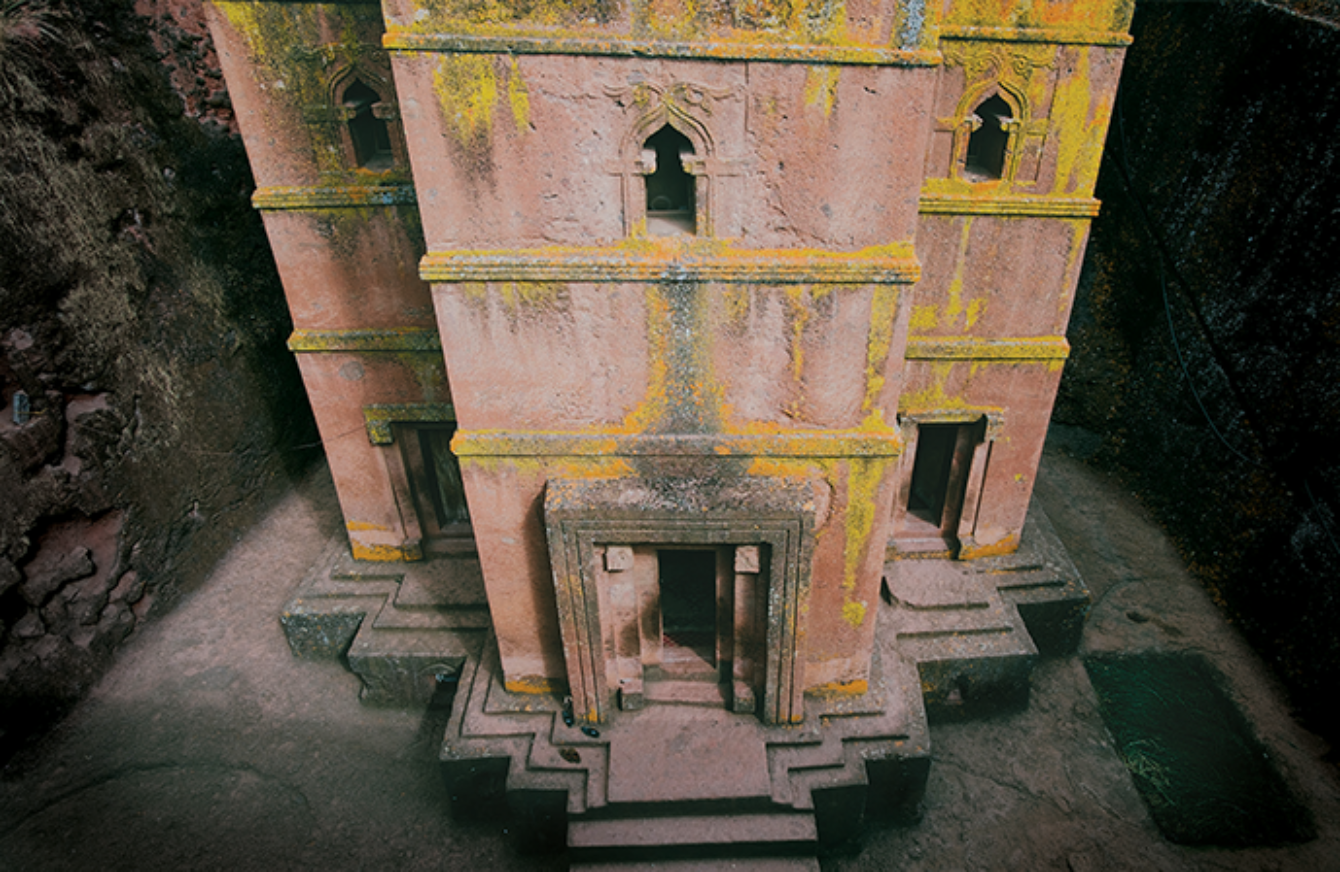
Biete Giyorgis
Mountains were never my element, though I grew up under the shadow of the Blue Mountains in northeastern Jamaica. It was the sea for me, laid out like a billowing turquoise gown below Stony Hill, on which stood my grandmother’s home in Port Antonio. Once famous for its tourism, Port Antonio is now splendidly antiquated, most of its shore lined with skeletal coconut trees, but the sea around it is divinity. For hours I would watch it rolling, from a flat rock at the side of my grandmother’s yellow house.
Pirate ships—the town’s European history began with pirates, before the state-sanctioned piracy of colonialism—brimmed the bay in my eyes. I was a solitary boy; Jim Hawkins was my idol. Those docked boats were really cruise liners, and the tourists they brought never stayed long, so the channel between the peninsulas below me was usually empty. I hovered above the open sea, my expanse of limitless blue, but never entered the water. Why? There is a contradiction to the serenity of the ocean: it is the crypt of the Middle Passage. I instinctively understood this pain before I heard any language about it, and every language I have heard since is insufficient. I understood the pain in a maternal way, for yearly during the hurricane season, my grandmother—who more or less avoided looking at the sea—would fasten her eyes on it, morning until night, her face racked with sorrow and her lips trembling. She was nervous about her house—she had indeed seen the havocs of hurricanes—but to me she seemed to be keeping vigil for the voices of drowned slaves. The season passed, and she continued on with her old silence.
As Theo and I moved on past damp, stunted cairns along the roughly quarter-mile trek to Biete Giyorgis, the sea returned to me. There was no dissonance in this. The sea returns whenever I feel joy, in its terrible immensity. When we arrived at the high vista surrounded by juniper and olive trees where the church plunged like a waterfall down into the earth, the rain stopped. The cross set into the large square roof of the cathedral floated in the light. The inlays of engraved stone rippled. Such light! Claritas! After-rain light. It was a low-grade silver, transmuting into amber: the whole landscape was arrested. The waiting light, I wanted to call it. The light of ascension as I went down into Biete Giyorgis, alone, Theo settling himself in one of the arched alcoves surrounding the church.
In that rain-swept silence, I marveled at the rosette terra-cotta monument, spotted with lichens that resembled bee pollen, Lalibela’s essence. The hulking structure embodied the mountain and at the same time emanated another. A silence opened within me: the astonishment at God’s infinite power within the stone. Who has sculpted the sea into a place of worship? Imagine an undersea cathedral; imagine fording to the deep unknown to know the Unknown. This was the great triumph of Lalibela. The king of that name rendered, with an important shift of preposition, what Christ said to Peter: “Upon this rock I will build my church.”
It was a superb grammar—the movement of a self in the rock—an experience Álvares never had. His journey as he tells it ends in a prodigious anticlimax. About Biete Giyorgis, he can only report: “The doors are very well worked outside.” He then adds tersely, “I did not go inside, as it was locked.” Lalibela himself also never stepped inside Biete Giyorgis. According to tradition, the masterpiece may be the king’s memorial, constructed by his widow after his death. The great house uniting Lalibela with St. George—Ethiopia’s patron saint—was therefore an act of love. Faith moves mountains; love moves mountains to heaven.
The doors were wide open when I approached. No one else was in sight—or not quite no one. Five hundred years ago, I was told, a pilgrim to Lalibela from Armenia decided he would not return home. (This decision is credible, given the power of the place.) He was still there, grayish-coral bones and all, preserved in one of the inset walls of the church, his feet pointing toward the doors.
The waiting light was there as I climbed the few steps to the doorway. I crossed the threshold into an ancient stillness. The interior was a mistier dark than in the other churches. Even so, I recognized immediately the aesthetic convention: the mixing of the simple and the elaborate finding a sublime pitch. The intensity of impression here was strongest, strangest. I felt I was standing in both the depth and the height of Noah’s ark. I was afloat: the rock was standing water. Was I alone inside that preternatural dark, shadows swirling around me? In a corner of the entryway was a heavy, coal-black cabinet with twines of beeswax candles and matches. I took and lit a candle—darkness made visible, as it were.
When I lifted the tapered flame, I saw the luminous ornaments of a tall, central altar enclosed by brilliant red-and-blue curtains. Because I could not see where the curtains hung from above, they seemed without beginning, flowing down from space. There were paintings of Christ similar in theme to those inside Biete Medhane Alem, though of brighter tones. Then my eyes caught a painting of stunning beauty and horror such that I had not seen in the other churches. It was a portrait of St. George slaying the dragon, and in an instant it consummated the splendor of the building.
The saint sits on his white horse, a red, gold-hemmed cape glimmering over his shoulder. His left hand gently reins the horse, and in his raised right hand he holds the spear still thrust through the dragon’s throat. A figure partially obscured by drapery—I could make out only a fold of his blue-violet tunic—lassoes the dragon by the neck. The dragon’s mouth is a V spitting out a glowing tongue. I advanced closer with the flame, a votive offering. Something came alive. A priest, lying down in a corner on the scarlet-carpeted steps, rose up; the candle flame ringed his eyes and caught the golden cross he held in his hand.
I looked to the painting, half expecting to see the horse without a rider or the mysterious tunic gone. Reflexively, I prostrated myself before the priest. He brought his cross down on my forehead with a subtle force and called my mind to another fire: the Nyabinghi nights at the shore in Jamaica.
I was a boy, chanting Ithiopia Ithiopia Ithiopia to thunderous drums. I was a little child, and my memories of those times are now partly fable. Certain faces in the crowd remain clear. Nighthawk’s came clear to me now, his matted liana-length dreads, dusted with sand, and his voice tremendous when he bellowed, “Jah Rastafari!” I was not too young to understand that we were sufferers who had found it possible to see the future. I somehow knew Nighthawk was crying psychic deliverance.
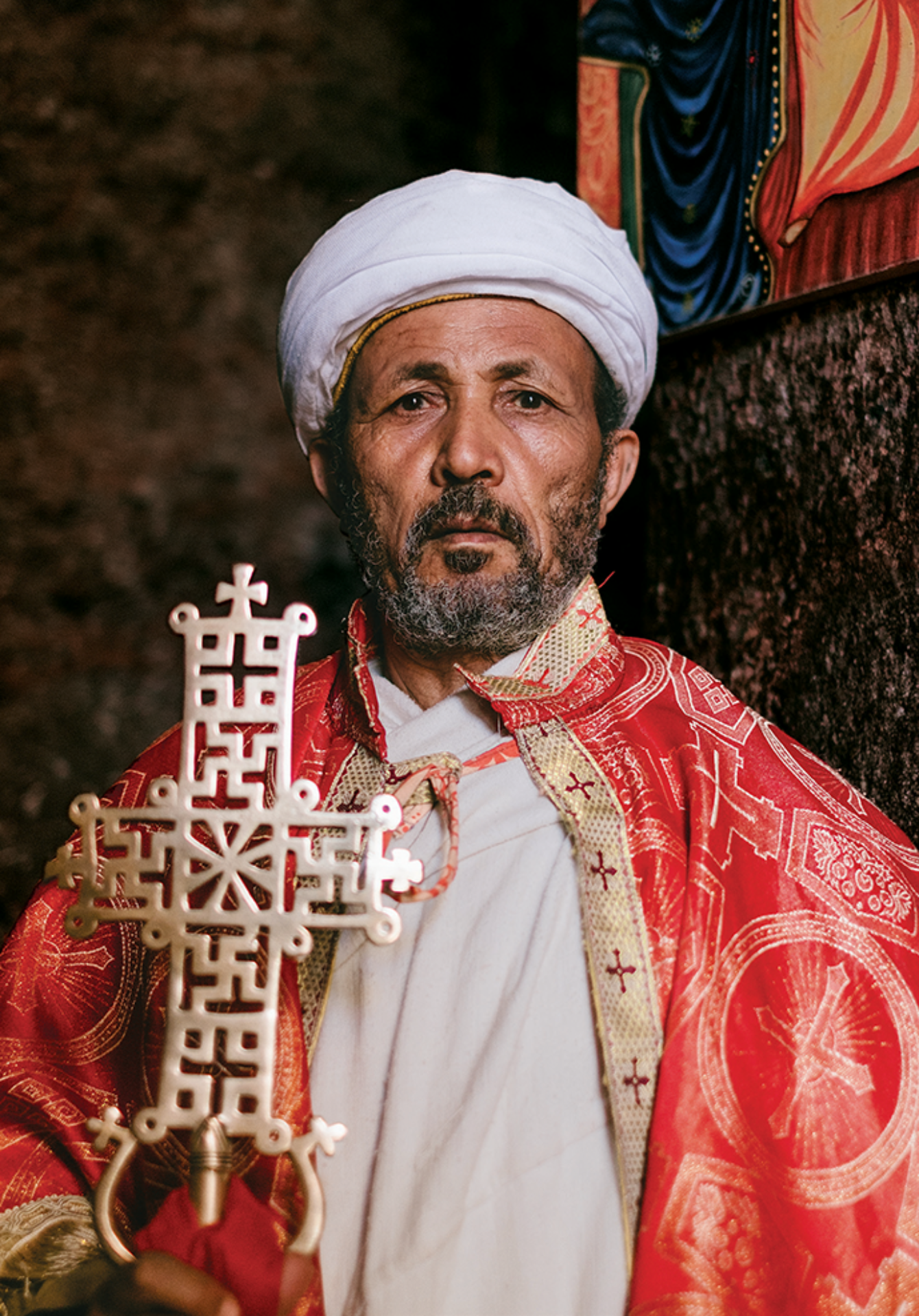
A priest from Biete Meskel
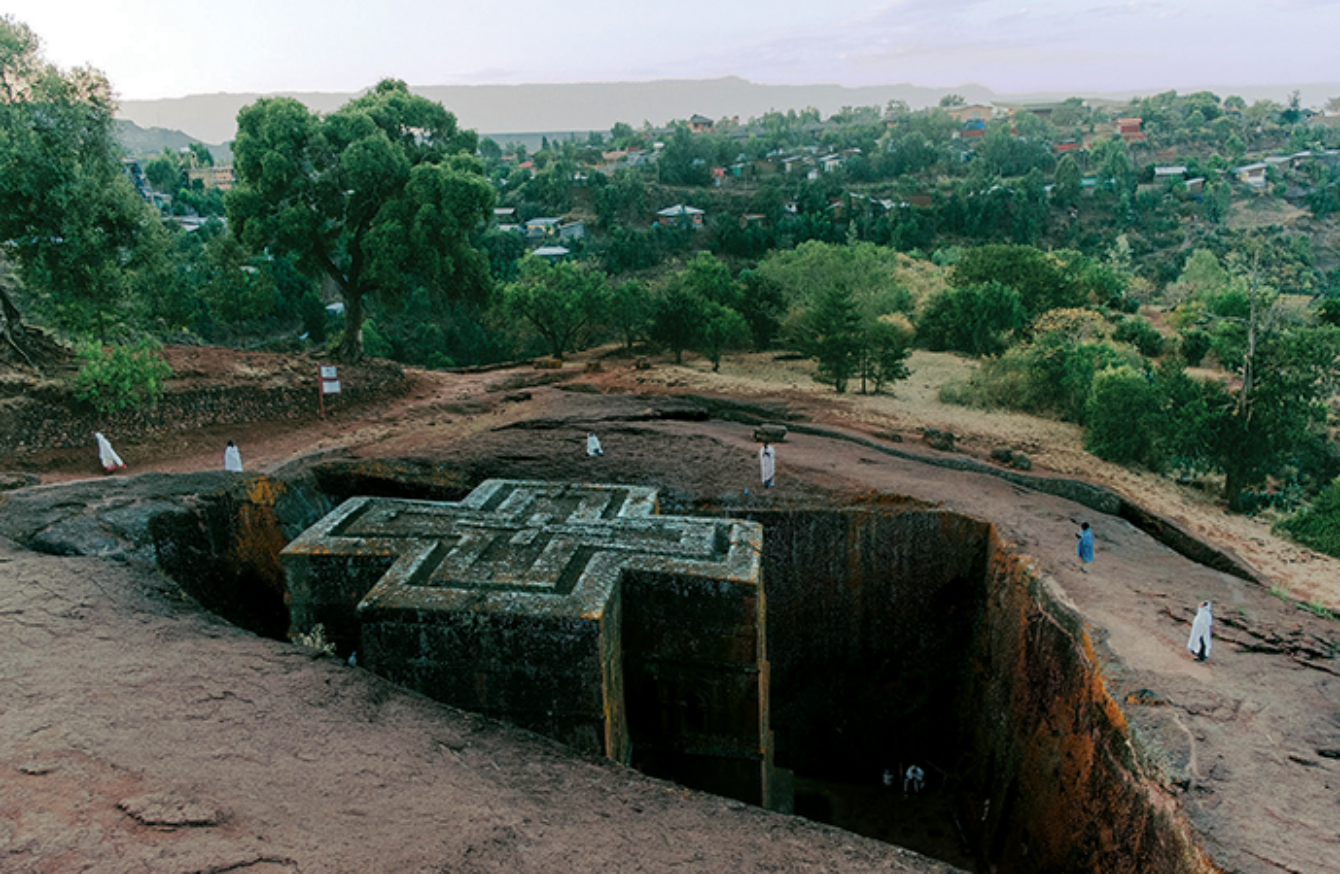
Biete Giyorgis, with the town of Lalibela in the background
Hours might’ve passed. It seemed centuries did in the pulse and flash of the flame. The priest lay back down again, motionless and mythical. And I, anointed with tears that shone in the fire, continued on. But I could not bear to see any more.
Outside in the twilight the air was cool, fresh as if it were the first of morning. Theo was waiting. We headed back to Sora Lodge, about an hour’s walk on foot. He allowed me to be with my thoughts. I sensed he knew the priest had consecrated the welcome he had given me by the boulder at the beginning of the journey. And for the rest of my visit, as if to honor that, Theo stayed mainly silent, like a spirit, by my side. The next morning when he came, unexpectedly, to wish me farewell over coffee on the veranda of the hotel restaurant—a driver who was a relative of his, with no English, had been arranged to drop me at the airport—he would again place his hand on my shoulder. His every word enacted a binding together, a prayer.
Returning through the half-dark village, I saw derelict homes perched near the macadam road, the people shimmering by. I felt like the diver in a poem by Robert Hayden who finds at the bottom of the sea a sunken ship full of human mementos—garments, instruments, shoes—and must now “somehow beg[in] the / measured rise.” The diver’s disconsolate encounter is not mine. Yet the question of what happens to a man after surfacing from such a discovery is mine. In such a discovery, one has come close to what is irredeemable in the world above. The diver yearns to find those people whom he calls the “hidden ones”—the drowned, those who live in a liminal death, still in transit to some port. No funerary rites, no closure: they are the voices I believe my grandmother heard. And the horror in the word “somehow”—the most appalling word, the most precise word of the postcolonial condition—that somehow one must go on. The encounter in Biete Giyorgis, brief and surprising, fortified my spirit to go on.
The people in Lalibela were biblical in the night. I saw them at open doors and under the infrequent streetlamps, some gathered at roadside fires, always two or more together, their muslins like folded wings down their bodies. The sky was crammed with stars, and it was cold by the time I was at my door. By then I grasped the mystery of being here. It is the way art moves the memory, the instinctive memory, of the original fire.
Poetry, what I live in and for, brings memory into the stele of the heart, and fragments of it survive on the page. Lalibela: a momentary—eternal—return to the fire. Ethiopia: Ithiopia Ithiopia Ithiopia, the inner call of my childhood I chanted by the sea until hoarse, until dawn became amber ash, from which glowed the answer to Samson’s riddle: “Out of the strong came forth sweetness.”
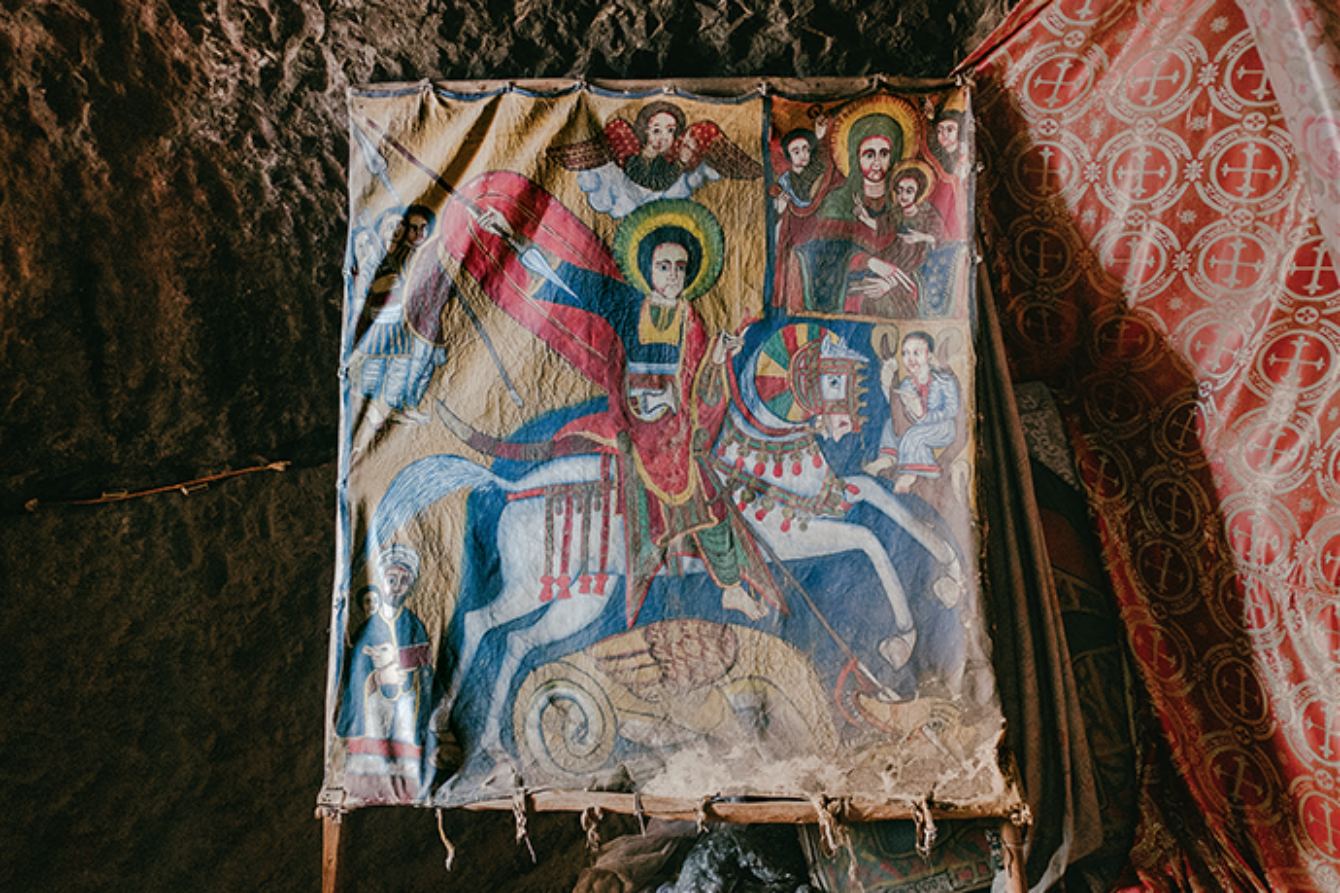
A painting of St. George and the Dragon in Biete Medhane Alem
The morning in Lalibela: the mountains and terraced hills revealed themselves muted malachite and brown. Abyssinian thrushes twittered in the eaves. Cow and goat noises came from the nearby yards. Cooking smoke went up from hearth fires that warmed the chill air. The breeze was fragrant with coffee beans, and from deep in the valley I heard the call of a farmer. A response from farther off came shortly and closed the distance between the two. Their voices died away, and the landscape reposed, as it always did.
There is often a slight melancholy to departure, if not outright melodrama. But what I felt that morning was the deepest, most sincere human pathos of all: nostalgia. Ethiopians call the condition tizita—defined as “the memory of loss and longing” by my friend the scholar Dagmawi Woubshet, who had given me refuge in his home in Addis Ababa. The memory of loss brought me to Lalibela. Some travels confirm the existence of a place. Some travels operate the other way around: a place, somehow, confirms your existence; arriving there crowns a survival no words can do sufficient justice.
Tizita is also a ballad in the Amharic songbook. Evenings in Addis Ababa, after roaming the city, Dag would play me versions of famous, and infamous, tizitas, in each the singer’s voice loaded with pain. Without any intention to, as I listened I heard the open wound of transatlantic slavery, the broken link my elders tried to make whole. I say heard but I mean I felt the unfathomable “ominous silence” W.E.B. Du Bois detects in the slaves’ sorrow songs. The closest Jamaican mode to tizita is dub music. Dub, in crude mus
ical terms, is reggae stripped down to drum and bass and given broad range inside an echo chamber. Dub’s reticence—of both lyrics and instrumentation—is broken by wails and what can sound like the quarry-boom of waves on cliffs. Every aspect of this sound shatters slavery’s strokes of amnesia. The music imagines, acts out, an inverse passage of slave ships on the cruel, beautiful sea. In it you hear the grotesque sounds in the hulls falling quietly away into ominous silence. A silence that is the sound of the sea at night by Grandmother’s house.
At dusk in Addis Ababa I had carried tizita in my ears and dub in my heart out to Dag’s garden. As I stood by the avocado trees, barely making out the faint illumination of the bougainvillea, the flamboyant hibiscus spilling over the concrete fence, worlds blurred: the continent had become my island.
Nostalgia haunted me on the road to the Lalibela airport. We drove cautiously past beautiful schoolchildren. They moved in a swirling crowd of excitement, fearless in the middle of the road. This was another image concomitant with home.
I had been simple like them, giddy with joy to see friends in the morning, to joke and to touch the hems of our khaki-and-blue school uniforms. The day of the first snow was a far fantasy. There was only today, and all I wanted was the sun, friends, and the gold of mangoes. I wanted to avoid the green, menacing cane always within view. The children on the road stared directly into my eyes, then away. There was a man departing, and nothing else.
Despite Lalibela’s enormous geographical area, it has a sparse population—only 17,000, comparable to my small hometown of Port Antonio. The tourism, because of the churches, is flourishing—tens of thousands of visitors come yearly. This has caused a minuscule uptick in population, bringing immigrants from the poor neighboring towns. In a close row at the roundabout of a main square, devoid of tourists, were the ramshackle stalls, each selling the same crafts: carved wooden crosses, embroidered shawls, and coffee cups with traditional effigies painted on them. Farther down the road, by two or three lookout points, under the scant shade of trees, children out of school uniform displayed the same crafts. The gift shop at the airport repeated the same, at a slightly higher cost.
In Port Antonio, tourism remains a major income generator. In Lalibela there is no hawking—only once did a teenage boy bearing a cluster of wooden crosses come up to the van window; he offered them shyly to me and then, after a brief moment, went back to his friends sitting on the stone gutter. The situation would have been different in Port Antonio: all the boys would have been at the window, for one. The nature of the tourism in both places is very different, too. The sacred is a limited commodity. In Port Antonio, with the beaches and party scene, a vendor has more to offer.
To live at the economic mercy of tourism is to be in a barely benevolent prison. And this prison is home. We drove by the new townships, squatters’ corners, standing out raw and exposed in the morning light, a kind of premonition of a harder future, one wherein poverty will breed violence. The traditional round huts of Ethiopia are disappearing, Theo had told me over coffee in the morning. Progress is a leveling evil. Hotels and pensions, in varying stages of development, are rising next to the nascent slums. The young are fearless but I fear for them. I worry, could it ever be enough, what they are given at school? How will they escape the struggle that will inevitably come? The cane fields in Jamaica eventually swallowed most of my friends. How I was spared that fate is a marvel I still find difficult to comprehend. It does not matter. There was so much delight among the children in Lalibela, parting and closing back together when the van passed through their midst.
The bright receptionist of my hotel, a boy born below the nearby bluff of Asheton Maryam, hoped one day to run his own villa there. He told me a website would help. If this happens, if he operates a villa in his own town, the people would benefit directly. He saw a possible future. I asked him about going to school in Addis Ababa or America, but that was not his real interest. His dream, a great courage, was to remain at home, to journey nowhere else. His name was Ambachew—roughly, “protector.”
I left him sitting behind the reception desk, reading to improve his English. Whenever he wished, he could get up and turn around to see the slate, crouching lion of his mountain home, beyond which I disappeared. His words were the last I heard before reaching the airport.

